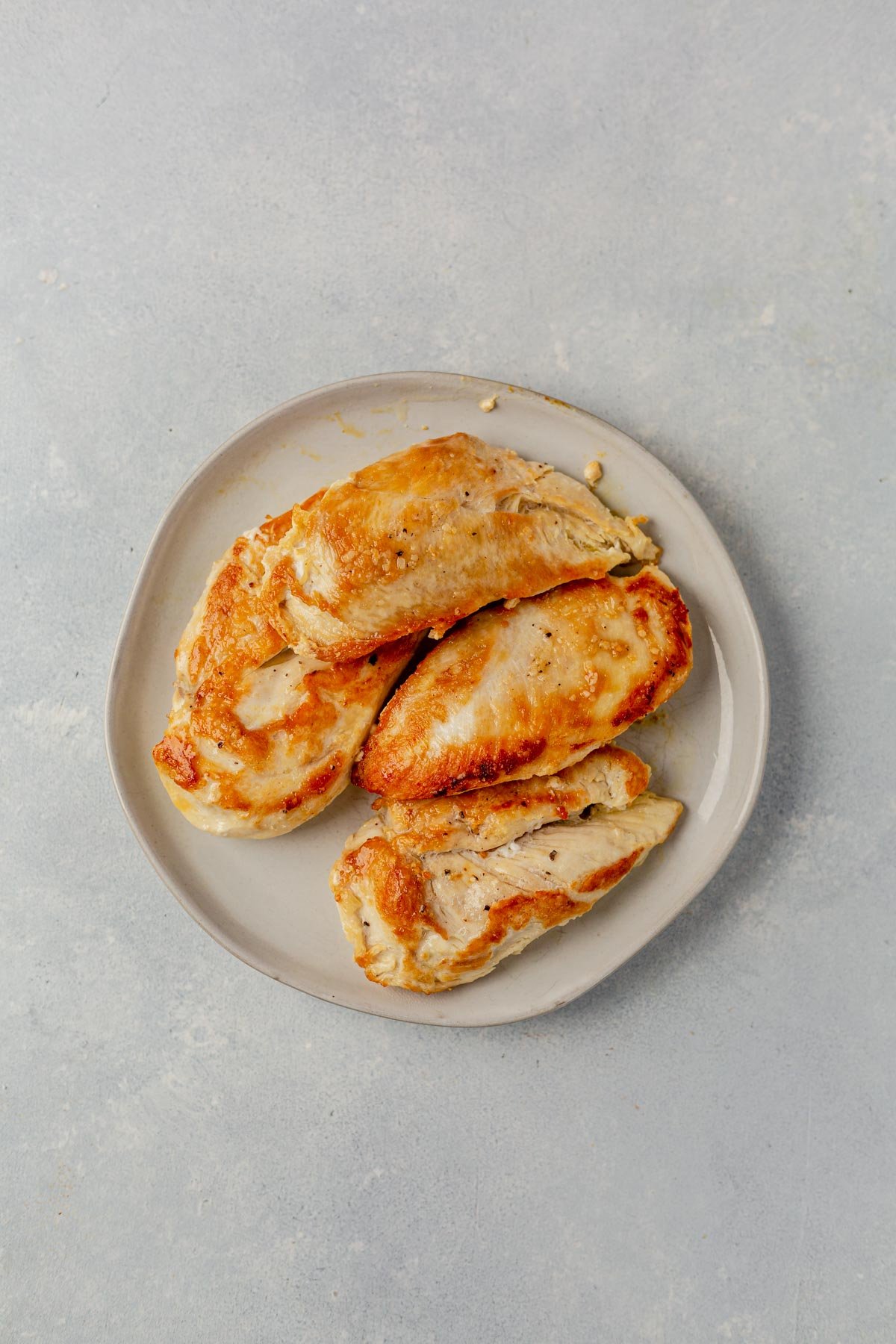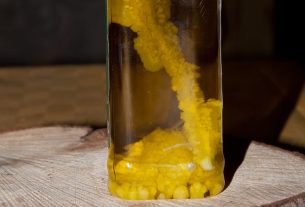Has your chicken ever turned out disappointingly rubbery?
Don’t worry, you’re not alone.
There’s nothing more frustrating than putting time and effort into a meal, only to be met with tough, chewy chicken.
But fear not!
In this article, we’ll uncover the reasons behind rubbery chicken and share some surefire ways to turn things around.
So, if you’re curious about the secrets to juicy, tender chicken, read on.
Your taste buds will thank you!
why is my chicken rubbery
Chicken can become rubbery if it is overcooked, undercooked, or of poor quality.
Undercooked chicken will have a shiny appearance and jiggly consistency, and it is unsafe to eat.
Poor quality chicken, such as chicken with white striping or woody breasts, can result in a rubbery texture regardless of the cooking process.
To prevent rubbery chicken, ensure it is cooked to a safe internal temperature of 165°F using a meat thermometer.
Slow-growing and organic chicken is ideal.
Adding more liquid and fat, as well as using cooking methods like slow cooking, braising, stewing, steaming, and simmering can also help prevent rubbery chicken.
Marinating or brining the chicken before dry heat cooking methods can also keep it tender.
To fix rubbery chicken, add more liquid and moisture while reheating it at low temperatures.
Key Points:
- Overcooked, undercooked, or poor quality chicken can become rubbery.
- Undercooked chicken is unsafe to eat and has a shiny appearance and jiggly consistency.
- Poor quality chicken, such as chicken with white striping or woody breasts, can result in rubbery texture regardless of cooking process.
- To prevent rubbery chicken, cook it to a safe internal temperature of 165°F using a meat thermometer.
- Slow-growing and organic chicken is ideal to avoid rubbery texture.
- Using cooking methods like slow cooking, braising, stewing, steaming, and simmering, as well as adding more liquid and fat can help prevent rubbery chicken.
why is my chicken rubbery – Watch Video
💡
Pro Tips:
1. Contrary to popular belief, overcooking is not always the reason behind rubbery chicken. The texture of rubbery chicken can also be caused by a protein called collagen, which tightens and toughens when cooked improperly.
2. One method to prevent rubbery chicken is to marinate it in acidic ingredients like lemon juice, vinegar, or buttermilk. Acids can help break down the proteins in the chicken, resulting in a more tender texture.
3. Interestingly, some chicken breeds, such as older heritage breeds, are naturally leaner and have less fat marbling throughout the meat. This can make them more susceptible to rubbery texture if not cooked carefully.
4. Another factor that can contribute to rubbery chicken is quick freezing and thawing. Rapid changes in temperature can cause the muscle fibers in the meat to contract and become tough.
5. Certain cooking techniques, such as using a slow cooker or pressure cooker, can sometimes lead to rubbery chicken. These methods may lead to overcooking or insufficient moisture, both of which can affect the texture negatively.
Causes Of Rubberiness In Chicken
Rubbery chicken is a common problem that many home cooks encounter. There are several factors that can contribute to this unappetizing texture. The first and most obvious cause is overcooking. When chicken is cooked for too long, the proteins in the meat become tightly coiled, resulting in a rubbery consistency. On the other hand, undercooked chicken can also be rubbery, but with a shiny appearance and a jiggly consistency. It is important to note that undercooked chicken is not safe to eat, as it can harbor harmful bacteria.
Another cause of rubbery chicken is poor quality meat. Factors such as white striping and woody breasts can lead to a tough and unpleasant texture, regardless of the cooking method used. White striping refers to white lines of fat that appear on the surface of chicken breasts. This condition is often the result of rapid weight gain in chickens, as they are bred to reach slaughter weight in a shorter period of time. Woody breasts, on the other hand, are characterized by a spongy and fibrous texture. A 2019 study found a correlation between woody breasts and the chicken’s body weight, suggesting that the rapid growth rate of modern chicken breeds may be to blame for this issue.
Shiny And Jiggly: Signs Of Undercooked Chicken
Undercooked chicken can easily be identified by its shiny appearance and jiggly consistency. When chicken is not cooked to a safe internal temperature, harmful bacteria such as Salmonella and Campylobacter may still be present. Consuming undercooked chicken can lead to food poisoning, causing symptoms such as nausea, vomiting, diarrhea, and abdominal cramps.
It is crucial to always cook chicken thoroughly to a minimum internal temperature of 165°F (74°C) to ensure it is safe to eat. Using a meat thermometer is the best way to determine if chicken is fully cooked.
To summarize:
- Undercooked chicken has a shiny appearance and jiggly consistency.
- Consuming undercooked chicken can lead to food poisoning.
- Symptoms of food poisoning include nausea, vomiting, diarrhea, and abdominal cramps.
- Chicken should be cooked to a minimum internal temperature of 165°F (74°C).
- Using a meat thermometer is recommended to ensure chicken is fully cooked.
“Cooking chicken thoroughly is essential to prevent foodborne illnesses.”
Poor Quality Chicken And Rubbery Texture
Poor quality chicken can contribute to a rubbery texture, regardless of the cooking process. Chicken with white striping or woody breasts often has a tougher and less palatable texture. The presence of white striping is a result of intensive breeding practices that aim to produce larger and faster-growing chickens. These practices can compromise the texture and flavor of the meat. Similarly, woody breasts are a consequence of rapid growth rate seen in modern chicken breeds. The fibrous and spongy texture of woody breasts can make the chicken feel rubbery and unappealing.
Link Between Woody Breasts And Chicken’s Body Weight
A study conducted in 2019 found a strong correlation between woody breasts and the body weight of chickens. The researchers discovered that the prevalence of woody breasts was significantly higher in heavier chickens. This suggests that the rapid growth rate of modern chicken breeds is a key factor in the development of woody breasts. While the exact cause of this condition is still not fully understood, it is believed to be related to muscle fiber damage and impaired development. This link between woody breasts and body weight highlights the importance of considering the quality and breed of chicken when aiming for tender and juicy meat.
Importance Of Using A Meat Thermometer For Safe Cooking
To ensure that chicken is cooked to a safe internal temperature, it is crucial to use a meat thermometer. Insert the thermometer into the thickest part of the chicken, avoiding bones and fatty areas. The USDA recommends cooking chicken to a minimum internal temperature of 165°F (74°C). This temperature is necessary to kill any harmful bacteria that may be present, such as Salmonella and Campylobacter. By using a meat thermometer, you can avoid the risks of undercooking or overcooking chicken, which can both result in a rubbery texture.
Adding More Liquid And Moisture To Fix Rubbery Chicken
If you have rubbery chicken, there are ways to salvage the texture and make it more enjoyable. One effective method is to add more liquid and moisture to the chicken. This can be done by incorporating a sauce, broth, or marinade into the dish. By simmering the chicken in a flavorful liquid, you can help soften the proteins and create a more tender texture.
Additionally, adding fats such as butter or olive oil can also help improve the mouthfeel of the chicken. The fats lubricate the meat fibers and can counteract the rubbery texture.
To summarize, here are some tips to improve rubbery chicken:
- Incorporate a sauce, broth, or marinade into the dish to add more liquid and moisture.
- Simmer the chicken in a flavorful liquid to soften the proteins and create a tender texture.
- Add fats like butter or olive oil to lubricate the meat fibers and counteract the rubbery texture.
“If you find yourself with rubbery chicken, there are ways to salvage the texture and make it more enjoyable.”
Slow-Growing And Organic Chicken For Tender Results
To prevent rubbery chicken altogether, consider opting for slow-growing and organic chicken. These chickens are typically raised in a more natural environment and given more time to develop. Slow-growing chicken breeds have a lower risk of developing issues like white striping and woody breasts, which can contribute to a rubbery texture. Organic chicken, on the other hand, is usually raised without antibiotics or hormones, resulting in healthier and tastier meat. By choosing high-quality chicken, you can significantly increase the chances of enjoying tender and juicy results.
The Role Of Liquid And Fat In Fixing Rubbery Chicken
When dealing with rubbery chicken, the addition of more liquid and fat can be beneficial. The liquid helps to moisten the meat fibers and create a more tender texture. Incorporating flavorful broths, sauces, or marinades can provide the necessary moisture to soften the proteins. Additionally, fats such as butter or olive oil can lubricate the meat fibers, counteracting the rubbery texture. By using liquid and fat, you can improve the mouthfeel of the chicken and make it more enjoyable to eat.
Cooking Methods To Prevent Rubbery Chicken
The cooking method used can greatly affect the texture of chicken. To prevent rubbery chicken, it is best to choose cooking methods that involve slow cooking, braising, stewing, steaming, or simmering. These methods allow the chicken to cook gently and evenly, resulting in tender and juicy meat. The slow application of heat breaks down the connective tissues in the meat, resulting in a more tender texture. On the other hand, dry heat methods such as grilling or baking can easily cause the proteins to become overcooked and rubbery.
Marinating And Brining Techniques For Tender Chicken
Marinating or brining the chicken before cooking can help maintain its tenderness. Marinating involves soaking the chicken in a mixture of acidic ingredients, such as lemon juice or vinegar, along with herbs and spices. The acid in the marinade helps to break down the proteins and tenderize the meat. Similarly, brining involves soaking the chicken in a solution of salt and water. The salt helps to draw out moisture from the chicken, creating a more tender texture. Both marinating and brining techniques can help prevent rubbery chicken and result in more flavorful and succulent meat.
💡
You may need to know these questions about why is my chicken rubbery
Why is my chicken rubbery but moist?
One possible reason why your chicken may be rubbery but still moist is due to overcooking. Chicken that is cooked for too long becomes tough and chewy, resulting in a rubbery texture. Moisture can still be retained within the chicken if it is cooked slowly and at a lower temperature, which may explain the moistness. However, the prolonged cooking time may have caused the rubbery texture.
Additionally, buying woody chicken breast could also contribute to this issue. Woody chicken breast refers to chicken that has been raised improperly or has too much connective tissue, resulting in a tough and rubbery texture. Even if the chicken is cooked correctly, the inherent quality of the meat can still result in a rubbery texture. It is essential to ensure the quality of the chicken before cooking it to avoid encountering this problem.
Is it safe to eat rubbery chicken?
Despite its unappetizing texture, rubbery chicken is safe to eat. However, it is advisable to avoid overcooked chicken as it may lose some nutritional value and become dry. Fortunately, you can still salvage rubbery chicken by utilizing different cooking methods or incorporating it into new recipes. With a little creativity, you can turn your rubbery chicken into a delicious and flavorful dish that will be enjoyable to eat.
Why is my chicken cooked but chewy?
There are several potential reasons why your chicken may be cooked but still chewy. Firstly, undercooking the chicken can result in chewiness, as the meat may not have reached the desired temperature to break down the muscle fibers adequately. On the other hand, overcooking the chicken can also cause it to become tough and chewy. This happens when the proteins in the meat tighten too much, resulting in a dry and rubbery texture. Additionally, leaving the chicken uncovered for too long while cooking can lead to moisture loss, leaving the meat dry and tough to chew. To ensure tender and juicy chicken, it is essential to cook it to the appropriate internal temperature and not exceed the recommended cooking time.
How do you fix rubbery cooked chicken?
To remedy rubbery cooked chicken, one effective approach is to immerse it in a braising liquid. This liquid can consist of various options, including a simple mix of water and spices. The chicken should be cooked at a low heat over an extended period, allowing the protein fibers to break down entirely, resulting in tender and soft chicken once again. Another option is to shred the rubbery chicken and let it simmer in a flavorful sauce, further enhancing its texture and taste.
Reference source
https://whatmollymade.com/why-is-my-chicken-rubbery/
https://greatist.com/eat/rubbery-chicken
https://www.tastingtable.com/658812/the-biggest-reason-your-chicken-is-rubbery/
https://slimmingviolet.com/chewy-chicken/



